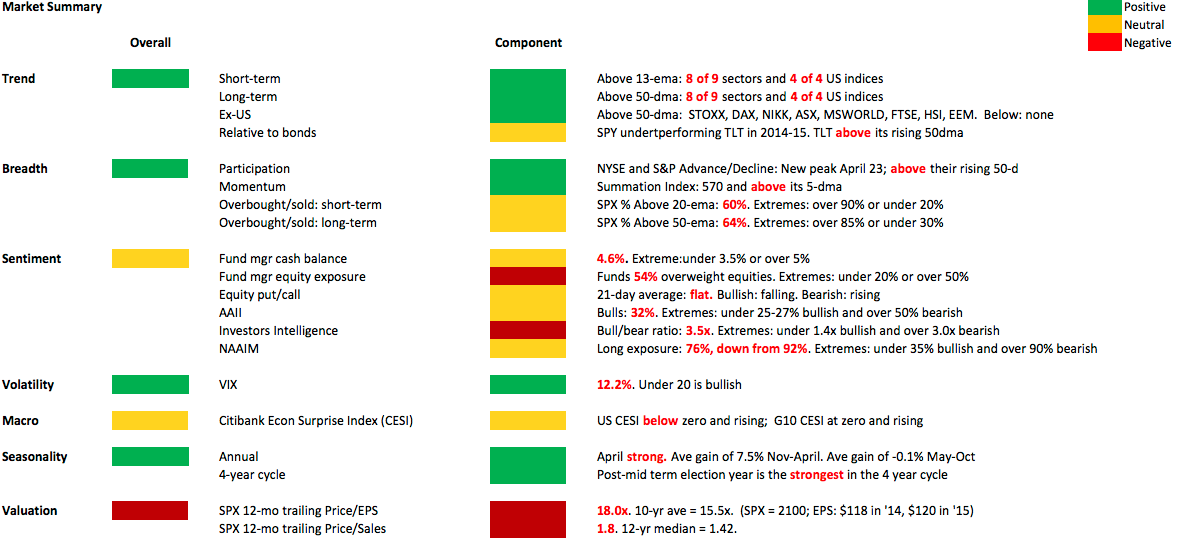Summary: new price highs are usually bullish as all investors are in a profitable position and not in need of selling. We don't like to be cautionary when price is bullish, but the reality is that prior moves to new highs have failed in the past year and several measures of breadth, sentiment and volatility suggest that is likely to be the case again now.
New bull market highs were formed by several indices this week. For the week, NDX was up 4.2%; it was the clear leader. SPDR S&P 500 (ARCA:SPY) gained 1.8% and RUT gained 1.2%. NDX and SPY made new highs; RUT and DJIA did not.
Overseas, iShares MSCI Emerging Markets ETF (ARCA:EEM) continued to lead, gaining 2.7%. Europe gained 1.2%.
After rallying 5 weeks in a row, crude took a break, losing 0.9%.
The broader NASDAQ Composite Index (COMPQ) closed at a record high for the first time in 15 years.
Making new highs shows a bullish trend. The recent challenge for the market has been sustaining momentum from one week to the next. NDX, for example, has still not been up two weeks in a row since mid-February.
Over the last several weeks, SPY has lost 2%, gained 2%, lost 1% and now gained nearly 2%.
To be succinct, the question going forward remains the same as it has been in recent weeks: will the market show bullish strength by becoming and staying overbought and thus trending higher, or will it continue the pattern of giving back most (or all) of those gains in subsequent weeks?
Starting with NDX, the picture looks very bullish. NDX traded in a 3 month range from November to January (yellow shading). It had been in a higher range the past 3 months, until Friday's breakout higher. It is overbought for the first time since February (top panel). The February breakout continued higher nearly 4%; optimistically, that could be the set up now as well.

SPY is much weaker than NDX: note how the trading ranges in November-January (yellow shading) and February-April overlap. Friday's "breakout" was fairly weak: it gapped to a new ATH yet managed just a small gain (0.2%) and it was on the lowest volume since December 26. It doesn't look like investors are aggressively buying the market.
Remarkably, SPY gained 3 days in a row this past week for only the second time since mid-February. The prior time was 2 weeks ago and SPY closed lower the week after. This is the absence of follow-through which has been the recent pattern. Will it follow through higher this time and show bullish strength?
RUT did very little this past week. It took all week to gain back what it lost a week ago in a single day. That's not aggressive buying. Momentum has been waning since the end of February (top panel). The longer term pattern is a rising wedge; these normally resolve downward when the bottom rail breaks.

The Dow is the weakest of the US indices. Momentum is barely positive (top panel) and price is at the same level as in early December. There are three lower highs over the past 2 months.

So, NDX looks very bullish: a big weekly gain to new highs and seemingly strong momentum. The other indices are not showing much upward momentum. Bullish markets impulse higher; they make it hard for buyers to climb aboard the trend. That doesn't seem to be the case here. SPY gained $3.70 this week but $2.30 came via overnight gaps. There was comparatively minor follow through during cash hours.
What's more, breadth is lagging. On Friday's new ATH, the number of stocks at even a 10-day high fell to just 20% (circle in chart below). There was no rush to buy stocks; it was a very selective rally.
This can be interpreted in two ways. A bullish interpretation is that there is plenty of room before the index becomes overbought; prior peaks have occurred after more than 50-60% of stocks are at a 10-day high. The bearish interpretation is that the breadth peak was in March; notice how the price peaks are always after the breadth peaks (arrows). The final part of each rally has a pattern of being on poor breadth. This ultimately causes the rally to fail.
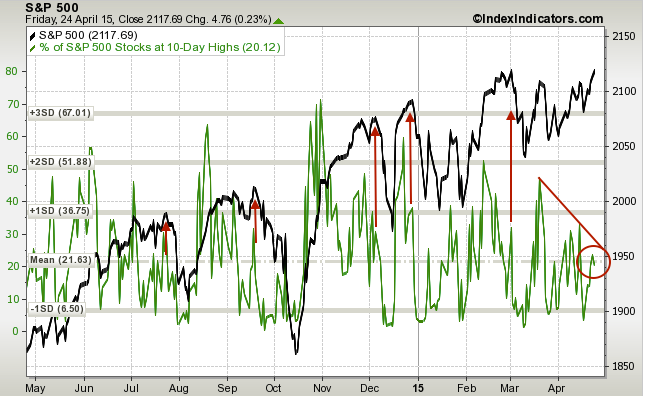
So which interpretation is right? On its own, there is no way to know. But what we do know is that breadth has been waning, without becoming oversold, for more than 6 months. In the past 5 years, SPY has never gone longer than 6 months before peaking and falling into a period where it becomes oversold (blue shading). Similarly long rallies are shown below. This one is now the longest.
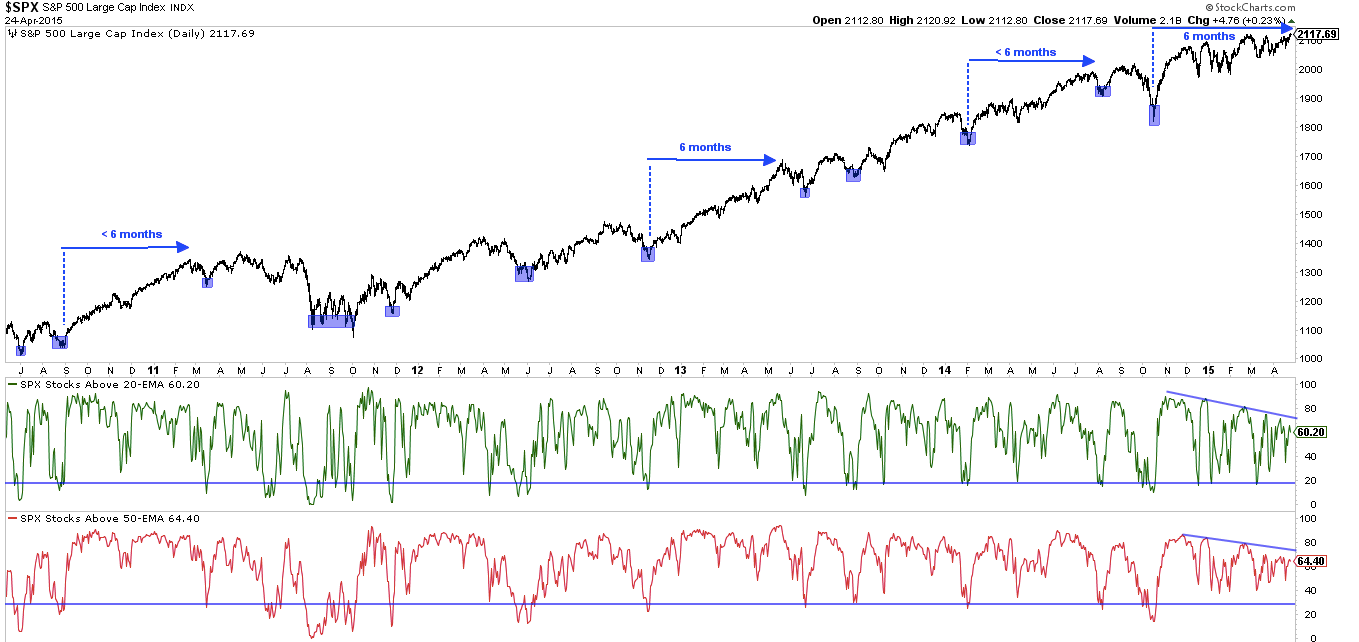
We can add that the price pattern in SPY has been for "breakouts" to new ATH to fail fairly quickly. Shown below are similar breakouts in the past year (yellow shading). SPY has mostly added to these gains but then quickly given up whatever was gained, and more, closing lower than the breakout level (blue lines). This suggests that SPY could move higher through the end of April before falling back in May (chart hat tip to Cobra).

Strength this coming week (the last week of April) and into early May would also fit the seasonal pattern (this week in yellow; chart from Almanac Trader). Recall that, over time, the November-April period produces average gains of 7.5% while May-October has average gains of 0%. In other words, what has traditionally been the bullish half of the year is now coming to an end.
Sentiment also suggests that whatever upside is ahead will be limited. We have previously shown the ISE equity-only call/put ratio and the BAML survey of fund managers (here). Both suggest poor risk/reward over the next month. We can add two other data points to these.
Sentiment measured by Mark Hulbert stands at 73% bulls, the third highest in the past 10 years (read here). The only two times it was higher, the DJIA fell 7% (January 2014) and 3% (February 2015). Over the past 15 years, the DJIA has averaged a negative return over the next 2 weeks and 1 month when sentiment is as bullish as at present.
Moreover, exactly 0% of the many indicators tracked by Sentimentrader are showing pessimism at present. This is in contrast to February's rally which was fueled by some pessimism (green shading). When this indicator has been 0% in the past year, SPY has ultimately traded lower (yellow shading).
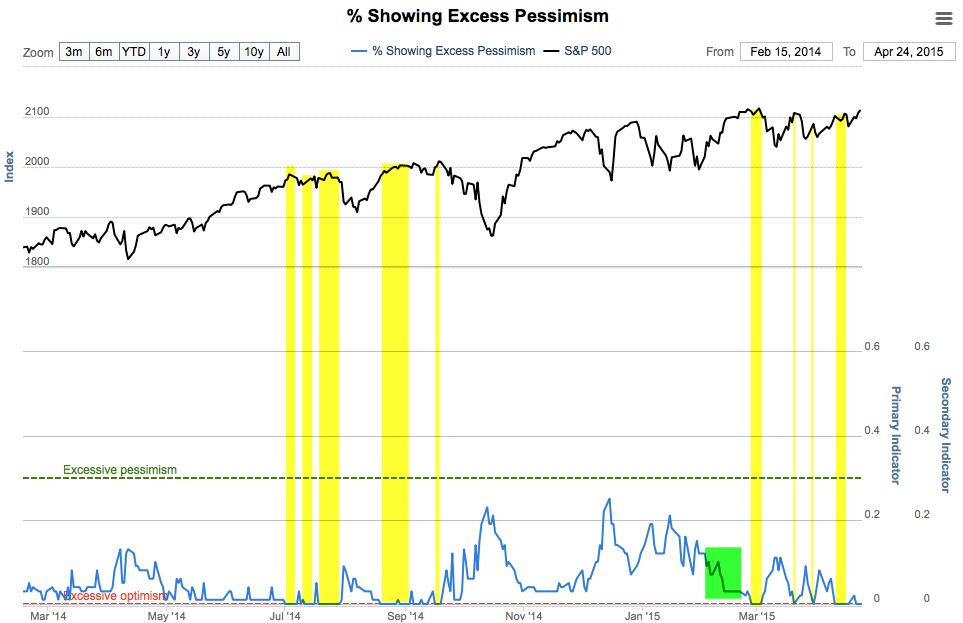
Finally, volatility, as measured by the VIX, fell to a new 2015 low on Friday. The 1 month relative to 3 month volatility measure, however, is now at a low from which it has been close to reversing (lower panel). Each time in the past 3 years, SPY has either traded lower (the last 4 times) or sideways with any gains given back within a month (shading).
There are two potentially big events this week.
The Fed meets on Tuesday and Wednesday. Expect them to repeat that they are watching the data to determine when to move on rates. As the data have recently been soft, they may indicate that weakness is 'transitory' and that they expect better data ahead. Until that actually transpires, expect no change in their policy bias.
The bigger event is Apple's (NASDAQ:AAPL)'s earnings report on Monday after the close. As the largest market cap company, their results are highly material. Unfortunately, there is no way to game the outcome. The last 4 reports have been greeted with upside (green arrows) but the pattern is evenly split over time. Notice that the movement in price has often been significant.
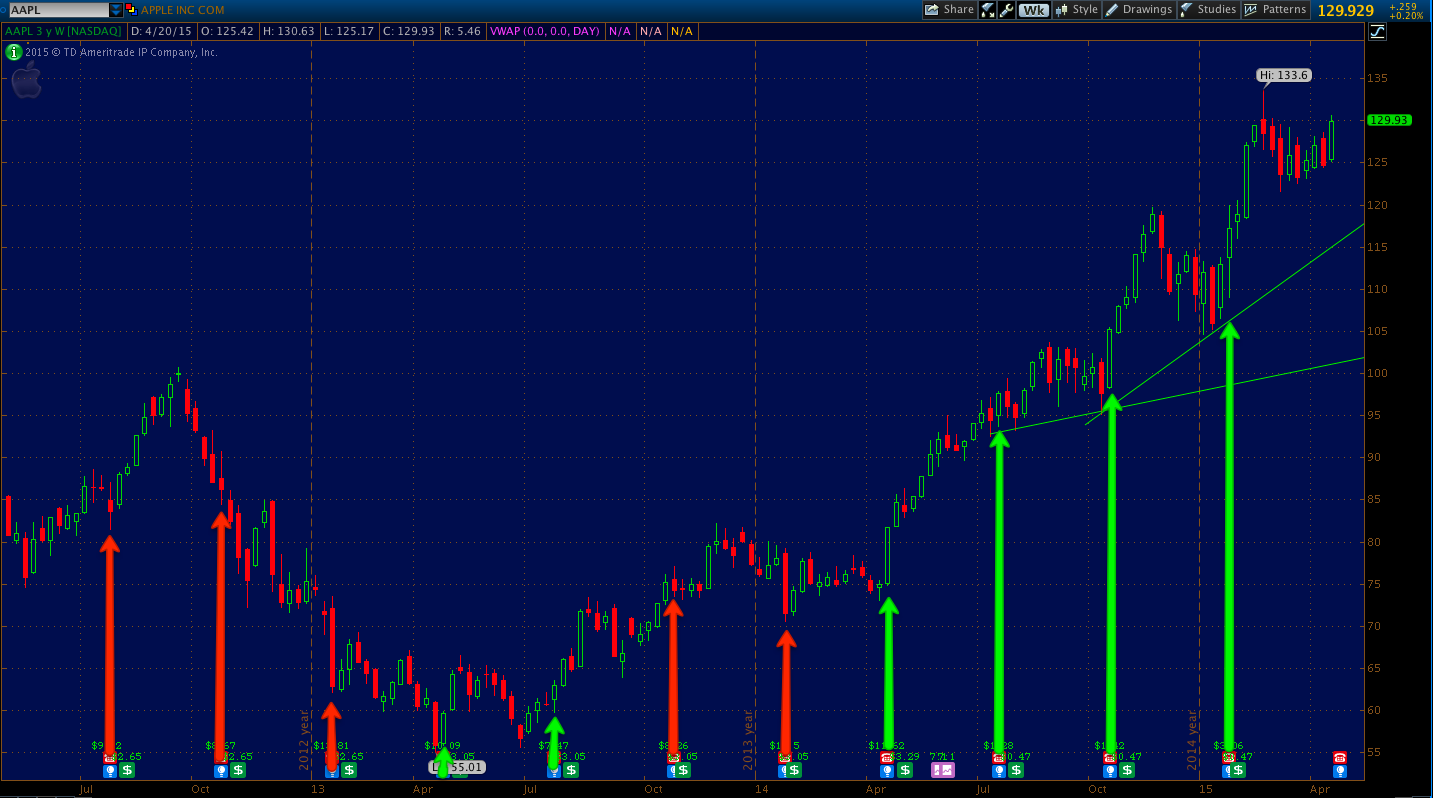
On a short term view, SPY has been trading in a rising channel for the past month. It is near the top of this channel; on strength, SPY could reach weekly R1 (red line; 212.8). This would meet the top of the channel later this week. The first support level is the weekly pivot (blue line; 210.8). Note the negative divergence in RSI; early weakness this week might be a back test of the pivot and prior highs. On more significant weakness, the weekly S1 is near last Tuesday and Wednesday's low (green line; 209.7). S2 is at the bottom of the channel.

In summary, new price highs are usually bullish as all investors are in a profitable position and not in need of selling. We don't like to be cautionary when price is bullish, but the reality is that prior moves to new highs have failed in the past year and several measures of breadth, sentiment and volatility suggest that is likely to be the case again now.
Our weekly summary table follows:
